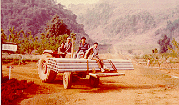
- Located on Tanaosri mountain, Doi Angkhang is just five kilometres from the Thai-Burmese
border. The climate is amazingly exotic by local standards. Situated 160 kilometres
north of Chiang Mai (40 km from Fang district) and 1,400 metres above sea level,
Doi Angkhang is cool all year round; temperatures can reach zero Celsius in winter.
- The weather not only allows cold-climate plants to grow, but it also attracts thousands of visitors to taste the winter chill each year.
 LOGO: Japanese pears
LOGO: Japanese pears

